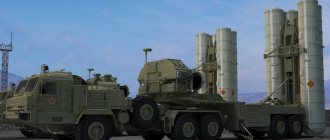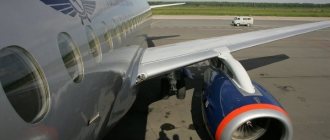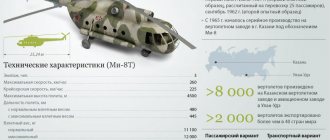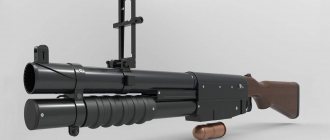“Angara” is a family of launch vehicles (LVs) of a modular type with oxygen-kerosene engines, which include carriers of 4 classes: from light to heavy - in the range of carrying capacities from 1.5 tons (“Angara 1.1.”) to 35 tons (“Angara-A7”) tons in low Earth orbit (launching from the Plesetsk cosmodrome). State Space Research and Production Center named after. M.V. Khrunichev became the main developer and manufacturer of launch vehicles of the Angara family.
Different modifications of the Angara are implemented through different numbers of universal rocket modules (URM) (UMR-1 for the first stage, and URM-2 for the second and third stages) - one module for light class carriers (Angara 1.1 and 1.2.) , three for the medium class carrier (“Angara-A3”) and five for the heavy class (“Angara-A5”).
The diameter of the URM is 2.9 m, the length is 25.1 m, the weight with fuel is 149 tons. The URM is equipped with an oxygen-kerosene engine RD-191.
100 billion rubles were spent on the implementation of the program (2013), as of the beginning of 2015 - 160 billion rubles. In the spring of 2018, Yuri Koptev, head of the scientific and technical council of Roskomos, announced a different figure - 110 billion rubles.
Thanks to the relocation of production to Omsk and the restructuring of the organization of production processes, the assembly of the Angara should have become cheaper.
On January 9, 2022, it was announced that the Khrunichev Center had begun creating a reusable stage for the Angara-1.2 light-class rocket.
Goals of creating the complex
- Russia needs a rocket system that could launch payloads from the territory of the Russian Federation into geostationary orbit (Plesetsk cosmodrome, and another possible option is the Vostochny cosmodrome). Today, the Proton launch vehicle is launched exclusively from the Baikonur cosmodrome, located on the territory of Kazakhstan.
- In terms of strategic security, the complex was completely developed and manufactured by the cooperation of Russian entrepreneurs located on the territory of the Russian Federation.
- Replacement of heavy launch vehicles with toxic fuel. As a rule, poisonous heptyl was used as fuel for “heavy” launch vehicles (in the USSR/Russia). Today it is used in the Proton-M launch vehicle. The Angara launch vehicle will use environmentally friendly fuel based on kerosene; Liquid oxygen acts as an oxidizing agent, so this pH is safer when used. In the future, it is possible to use the Ankara launch vehicle for manned flights.
- Modularity. It allows you to simplify the delivery of the product by rail to the launch site. Thanks to the modular construction concept, it makes it possible to develop a whole family of launch vehicles: light class (based on the first module of the first stage with a payload weight in low Earth orbit of 1.5 tons), heavy class (up to 35 tons, consisting of seven universal rocket modules included included in the first stage).
- The payload of the Angara A5 launch vehicle is up to 25 tons, which is more than that of the Proton launch vehicle. These technical indicators of the Hangar A5 make it possible to launch a payload of the same weight from the Plesetsk cosmodrome as from the Baikonur cosmodrome using the Proton-M launch vehicle.
As a result of the creation of the Angara, the Khrunichev State Research and Production Space Center can occupy almost the entire domestic space launch market by developing on its basis the URM, a single replacement for many types of launch vehicles created in the USSR:
- "Angara" A5, A7 instead of "Proton" (the fuel was based on toxic high-boiling components)
- “Angara A3” instead of “Zenit-2” (manufactured in Ukraine exclusively for the Sea/Land Launch project, production was stopped after 2013)
- "Angara A1.2" instead of "Cyclone-2/3" (discontinued in Ukraine)
- “Angara A1.1” instead of “Cosmos-3M” (fuel based on toxic high-boiling components, discontinued in the 90s).
Only the RN R-7 series (Soyuz/Molniya) remained without replacement, as well as light conversion carriers built on the basis of ICBMs. The technique of creating a unified series of launch vehicles became the topic for the dissertation of the First Deputy General Director of the Khrunichev State Research and Production Space Center A.A. Medvedev, which was defended in 1999 (A.A. Medvedev was appointed General Director of the Khrunichev State Research and Production Space Center in 2001). In addition, there were reasons to believe that over time, a significant part of the Soyuz launch vehicle loads should “migrate” to a higher level and it was assumed that they would move to the Angara-A3 launch vehicle.
Content
- 1. History
- 2 Technologies 2.1 Rocket design
- 2.2 Engines
- 2.3 Fuel
- 2.4 Use of composite materials
- 2.5 Effect of missile unification
- 6.1 Unit cost of cargo launches
- 7.1 Angara-1.2
- 8.1 Plesetsk
- 10.1 Launches
Development timeline
- After the collapse of the USSR, the Baikonur cosmodrome, from which the heavy Energia and Proton launch vehicles were launched, ended up outside the Russian Federation. There was a need to develop a heavy-duty launch vehicle, all components of which would be produced from domestic components on a Russian production base, and launches would take place from cosmodromes located in Russia.
- On August 3, 1992, on the basis of the Decision of the Scientific and Technical Council of the Aerospace Forces from the Decree of the Government of the Russian Federation of September 15, 1992 on the issue “Guidance means: the state and prospects for their modernization and development,” a competition was announced for the development and creation of a heavy-class space rocket complex (KRC) . RSC Energia named after academician S.P. took part in the competition. Korolev, State Research Center "KB named after. Academician V.P. Makeev, State Research and Production Space Center named after M.V. Khrunichev, who presented several versions of the RN for consideration by a specially formed Interdepartmental Expert Commission.
- In the summer of 1994, the competition was won by the option proposed by the State Research and Production Space Center named after M.V. Khrunicheva. As a result, this organization was appointed as the lead developer. The rejected proposal of RSC Energia in the future began to serve as the basis for the creation of the Rus-M family of launch vehicles.
- By the Decree of the President of Russia of January 6, 1995 “On the development of the Angara missile complex,” the creation of the missile system was defined as work of special importance. In March, an order was issued by the Russian Ministry of Defense regarding this complex.
- At the end of the summer of 1995, a new Decree of the Russian Government was issued, which determined the stages of creation of the Hangar complex, the master plan for the creation of the complex, its financing and cooperation of co-executors was approved. The resolution determined the date for the start of flight tests - 2005 and the location of the USC of the Plesetsk cosmodrome (site No. 35, the unfinished Zenit launch vehicle complex), and in the future the use of the Hangar launch vehicle for launches and the Svobodny cosmodrome is envisaged. The project that entered service provided for the development of a two-stage LV package arrangement of tanks with further operation of the stages using liquid oxygen as an oxidizer, and kerosene in the role of fuel in the 1st stage, and liquid hydrogen in the 2nd stage. The fuel tanks were located on the sides of the oxidizer tanks located in the center. This scheme began to be called “Cheburashka”, since the fuel tanks located on the sides were similar to the ears of a cartoon character. The first stage engine was RD-171, developed for the Zenit launch vehicle. The second stage engine is RD-0120, which was previously used on the central block of the Energia launch vehicle. The launch weight of the launch vehicle is 640 tons, the mass of the payload, which is launched into low Earth orbit with an inclination of 63°, is 24.5 tons (from the Plesetsk cosmodrome). The choice of the first stage engine made it possible to use the launch complexes of the Zenit launch vehicle for launch, namely, to retrofit the corresponding unfinished launch complexes at the Plesetsk cosmodrome. RKK Energia (Korolev) worked on the development of individual parts and systems - they were engaged in the entire design of the second stage, NPO Energomash (Khimki) - specialized in first-stage engines, KB Khimavtomatika (Voronezh) - specialized in second-stage engines, GRC Design Bureau named after V.P. Makeev - carried out work on fuel tanks, Design Bureau of Transport Engineering (Moscow) - on the ground launch complex.
- Research Institute KHIMMASH (now FKP "National Research Center RKP") - for ground testing of the KKR.
- In the spring of 1997, the leadership of the State Research and Production Center named after M.V. Khrunichev proposed to completely revise the adopted version of the Angara launch vehicle in 1995. Gradually, a modern launch vehicle design based on universal rocket modules and using kerosene as fuel at all stages began to emerge. Without holding a Scientific and Technical Council and a new competition, by the decision of the head of Rosaviakosmos Yu.N. Koptev and with the consent of the Russian Ministry of Defense, a new scheme was adopted, and RSC Energia and the Makeev State Research Center were excluded from the list of co-executors.
- In the winter of 2007, 3-month tests of the launch vehicle, which took place at the Research Institute of Chemical Engineering near Moscow, were completed.
- At the beginning of the fall of 2008, the URM-2 LV "Angara" was delivered to the FKP "National Research Center RKP" (formerly the Research Institute KHIMMASH, Peresvet in the Moscow region of the Sergiev Posad district) for the purpose of undergoing fire tests. The planned activities are part of the mandatory training cycle for the rocket and space technology being developed.
- On April 29, 2009, the first series of cold tests of URM-1 was carried out at the Scientific Research Center of RKP, the oxidizer tank of which was filled with approximately 100 tons of liquid oxygen. The main goal of HSI-1 is the comprehensive testing of pneumatic hydraulic systems for engine power supply, as well as control algorithms for liquid oxygen gas generators.
- On June 18, 2009, the second cold tests using both fuel components were carried out at the Scientific Research Center of RKP. At the current stage, a comprehensive test of the operation of the pneumatic hydraulic power system was carried out under bench conditions during “cold” spills of fuel and oxidation tanks.
- On July 30, 2009, fire tests of the URM-1 module of the Angara launch vehicle were carried out at the FKP "National Research Center RKP" at stand IS-102.
- On November 26, 2009, fire testing of the URM-1 module of the Angara launch vehicle was completed at the FKP "SRC RKP".
- On November 18, 2010, successful fire bench tests of the URM-2 rocket module of the Angara launch vehicle were carried out at the FKP "National Research Center RKP". The main purpose of the fire bench test is to comprehensively test and confirm the performance of the pneumatic hydraulic systems of the product under bench conditions when operating with the RD-012A-I engine, reproducing the operating modes of the propulsion system according to the flight cyclogram. Fire bench tests are the final stage of ground testing of the URM-2, preceding flight tests.
- On May 23, 2011, an interdepartmental commission formed by a joint decision of the Space Forces of the Russian Ministry of Defense and the Federal Space Agency signed an Act, which stated that the RD-191 engine had successfully passed the ground processing stage and could be used with the Angara launch vehicle.
- In the spring of 2012, he conducted successful factory tests of the first light-class vehicle weighing 197 tons, consisting of 2 transport and installation units, for the Angara launch vehicle launch complex. The equipment is used to transport and install heavy and light class rockets at launch.
- In the fall of 2012, the test tests of the Angara launch vehicle components were completed. According to the Federal State Unitary Enterprise GKNPTs named after Khrunichev, at the FKP “National Research Center RKP”, the cryostatic strength tests of the structural components of the promising Angara launch vehicle (assembly No. A13 - product A5A2C) manufactured by the Federal State Unitary Enterprise “GKNTsP im. M.V. Khrunichev." The main purpose of testing this assembly was to confirm the strength of the 3rd stage accelerator compartments of the launch vehicle and individual structural components of the Anagara launch vehicle 3A and 5A.
- The universal rocket module URM-1 underwent flight tests 3 times (2009, 2010 and 2013) as part of the KSLV-1 launch vehicle as the first stage.
- The first manned launch of the Angara launch vehicle from the Vostochny cosmodrome was planned for 2022.
- The Accounts Chamber of the Russian Federation stated that the funds that have been invested in the project over 20 years have increased the cost of this, not yet fully completed, carrier many times over.
- In the summer of 2015, NPO Energomash began developing an improved version of the RD-191 engine - RD 191M, which will be used on the Angara-A5V and Angara-A5P rocket launchers and will be superior in power to its predecessor. The first stage of the launch was completed in the fall of 2015. It was planned to complete development work by 2022.
- In the winter of 2022, the Khrunichev State Research and Production Space Center announced that the development of a reusable version of the Angara launch vehicle had continued. OKM Myasishchev and Roscosmos confirmed the information about the completion of the work. The aviation design bureau reported that the first results could be announced in the spring of 2022. At this point, the technical image of the reusable “Angara” will be selected. This will be done by colleagues of the Military-Industrial Commission, which will have to resolve the issue of financing.
- At the end of June 2022, a large scientific and practical conference was held in Moscow on the topic: “The main objectives and prospects for the development of the State Corporation “ROSCOSMOS”. During the conference, Dmitry Rogozin announced that summer testing of the family of new Russian Angara launch vehicles will end after 6 launches.
- In 2022, after the mock-up was purged in the TsAGI wind tunnel, some changes were made to the design of the Angara-A5 launch vehicle.
[edit] Technologies
The “Angara” uses a new modular construction principle, newly developed engines, a new control system, a new design manufacturing technology, etc.[12]
[edit] Rocket design
Rocket engine RD-191
For the first time, when developing the Angara, the modular principle was taken as a basis. Carriers of different carrying capacity are assembled from standard module blocks with a high degree of interchangeability. The basis of the rocket system is the universal rocket module (URM), which is a complete structure consisting of oxidizer and fuel tanks. The URM is used in the first (URM-1) and second (URM-2) stages of the rocket. URM-1 underwent successful flight tests three times (2009, 2010, 2013) as part of the South Korean launch vehicle KSLV-1.[13]
A light-class rocket has two stages, a heavy-class rocket has three. As the upper stage, the use of upper stages is envisaged: “Briz-KM”, “Briz-M”, oxygen-hydrogen medium class (KVSK) and oxygen-hydrogen heavy class (KVTK). The serial "Angara-1.2" includes two universal modules, "Angara-A5" - six, "Angara-A7" - seven.[14]
[edit] Engines
Each module of the first stage of the rocket is equipped with one single-chamber liquid rocket engine (LPRE) RD-191 developed by NPO Energomash (Khimki, Moscow region), running on kerosene. The second and third stages use the RD-0124A liquid propellant engine from the Chemical Automatics Design Bureau (KBHA; Voronezh).[15]
In the future, in the upper stage it is possible to use liquid rocket engines RD-0146 and RD-0146D developed by KBHA (RD-0146D is being created for the Angara-A5 upper stage).[16]
[edit] Fuel
"Angara" runs on environmentally friendly fuel - kerosene, the oxidizing agent of which is oxygen. After burning kerosene, only water and carbon dioxide remain. Previously, all Russian heavy-class missiles flew only on toxic heptyl.[17][18]
[edit] Use of composite materials
About 36% of the rocket parts were made from third-generation composite materials, which reduced the overall specific gravity of the entire system by 12.3%.[19]
[edit] Missile unification effect
“Angara” was created in the form of a construction kit that can be quickly assembled depending on the tasks at hand, transported without the use of expensive energy-intensive systems and installed at the launch complex in a matter of minutes. At the same time, the launch complex, which usually consumes up to 40% of the investment, only needs one for all categories of rockets of the family. Although each class of rockets in the world uses a separate launch pad designed for it. Thanks to this unification, savings of about 30% of the total budget for development and production and about 24% in operating costs are achieved.[20]
Transfer of production from Moscow to Omsk
The Khrunichev Center decided to launch Angara production at Polet (Omsk), since the carrier is being developed using excellent Proton production technologies, for example, argon-arc welding is used for Protons, as well as all technological connections built around it. Friction welding was introduced by specialists. In addition, in terms of efficiency of transport logistics, Polet is ideally located - almost at the same distance from the Vostochny and Plesetsk cosmodromes.
At the initial stage, the side and central blocks of the launch vehicle (first and second stages, URM-1) will be assembled at the Polyot Production Association in Omsk and the Khrunichev Center in Moscow. The units will be able to undergo additional checks and the launch vehicle will be assembled together with the 3rd stage and the integration of the upper stage, after which the Angara launch vehicle will be sent to the Plesetsk cosmodrome for pre-launch preparation.
According to the plan, starting from 2022, Polyot PA will produce the 3rd stage (URM-2) itself. In January 2022, the general director of the Khrunichev Center, Alexey Varochkov, told reporters that stage 3 would begin to be produced in Omsk before 2022. Thus, 6 Angara-A5 missiles were made in Moscow, and complete assembly in the city of Omsk will begin only with 70 missiles and will be carried out according to new design documentation through friction welding.
In 2007, the Polet PA became part of the Khrunichev Center. The first stage of modernization and reconstruction began in 2009, then the investment amount was 6 billion rubles. The second stage required large investments - 10 billion rubles. How much was invested in the third stage is unknown, but it should end with the transition to the production of more than twenty universal rocket modules for the Angara per year.
Until 2015, fuel tanks for URMs were produced in Omsk. In the same year, a decision was made to locate the Angara missile on the production site.
On May 10, 2016, the media learned that the production and testing of the side and central blocks for the 2nd flight prototype of the Angara-A5 was delayed by 3 months as a result of problems with testing and production. According to him, the reason for the delay is the lack of modern supplies of components and the availability of not all equipment for testing. It also took a long time to set up production in Omsk.
On August 2, 2016, Viktor Nazarov, the governor of the Omsk region, told reporters that in September 2016 a workshop would be launched where the Angara would be assembled from start to finish.
On August 26, 2016, Viktor Nazarov, the governor of the Omsk region, told the media that starting from 2022, Polet PA will become a center for the production of rocket modules for Angara, producing up to 100 URMs per year. It will be the only one on Russian territory. About 7 billion rubles have already been invested in modernizing production.
On February 28, 2022, Viktor Nazarov told reporters that in the second quarter of 2022, Angara will be assembled at the Polet enterprise, since the process of introducing a full technical production cycle is already underway, which is under strict control by the Federal Agency for Special Construction.
In the spring of 2022, General Director of the Khrunichev Center Andrei Kalinovsky told reporters that the enterprise, with the consent of the Russian Ministry of Defense (the main customer of the Angara), postponed the launch of the carrier to 2022 as a result of the protracted process of transferring production to Omsk to confirm readiness in terms of quality manufactured products, personnel qualifications and stability of technological processes. All tests, including bench tests, should be prohibited in the Central Research Institute of Mechanical Engineering in 2022, after which production can be launched at the Polet PA.
In the summer of 2022, the Ministry of Transport, Industrial Policy and Innovative Technologies of the Omsk Region told reporters that the assembly shop for URMs for Angara would begin work at Polet in July.
Deputy Prime Minister D. Rogozin on August 25, 2022, during a meeting at the Khrunichev Center, said that part of the production in Moscow, in particular, is not ready, the galvanizing workshop, which was sponsored back in 2014, due to one of the heads of the Spetsstroy of Russia.
On October 10, 2022, Alexey Varochko, acting general of the Khrunichev Center, told the media that the Omsk branch had received an order for the production of ten Angara missiles from the Russian Ministry of Defense. On October 11, the Ministry of Industry, Transport and Innovative Technologies of the Omsk Region also confirmed this information, adding that the state order was designed for the period 2018-2025 and involves the assembly of 2 versions of the Angara 1.2 launch vehicle. and "Hangars - A5".
At the beginning of 2022, the Khrunichev Center at TsNIIMash carried out selection and strength tests of one of the URM-1 universal rocket modules for the first stage of the Angara-A5, which continued for several months and began at the end of 2022. The main objective of the test is to check the technology of production readiness in the Polyot Production Association, which was organized using modern technological equipment, equipment and advanced production processes, for serial production of the Angara launch vehicle.
In the early spring of 2022, Deputy Prime Minister D. Rogozin, following a visit to Polet, announced the start of work on modernizing the Angara-A5: the rocket needs to be lighter and its thrust-to-weight ratio increased through the use of composite materials, as well as the transition to modern welding , which can improve flight performance by 15 percent. In addition, the establishment of cooperation schemes within the Roscosmos company will help launch serial production of the heavy Angara in 2021. In addition, the Deputy Prime Minister instructed technologists from the Polyot Production Association and the Omsk branches of Almaz-Antey and UEC to discuss on March 5 the indicators for creating a single competence center for electroplating. The galvanizing shop should be built back in 2014. More than 250 million rubles have been allocated for its creation, and today about 65 million more are required and an extension of the deadline for the supply of necessary equipment until May 2022.
March 30, 2022 Sergei Golovinsky On March 30, 2022, during the visit of Alexander Burkov (acting governor of the Omsk region), he stated that the complete transfer of production of the Angara-1.2 launch vehicle to the Omsk Aerospace Association should occur in 2022, and the Angara-A5 launch vehicle - until the end of 2022.
In the summer of 2022, the head of Roscosmos D. Rogozin told reporters that serial production of the Angara launch vehicle will begin in 2023 at the Omsk Polyot Production Association. All production will move there, while the Khrunichesv Center in Moscow will be transformed into a design bureau.
In the winter of 2022, D. Rogozin announced that until 2023, 2 Hangars would be produced in the city of Omsk every year. Starting in 2023, “Angara” will be put into mass production. According to the production program, it is planned to produce up to 44 universal rocket modules, which, according to their modular design, will be folded like “Angaras” of a heavy or light class.
Expected Events
- Release of the first "Angara-1.2.", assembled in the Polet software - 2020.
- Construction of the 2nd control and testing stand for the production of Angara-A5.
- The release of the first Angara-A5, assembled at Polet, is 2022.
[edit] Cosmodromes
[edit] Plesetsk
The first Angara launches were made from the Plesetsk cosmodrome, where a universal launch complex was built.[33]
The Russian Ministry of Defense plans to build a new launch complex for Angara family rockets at the Plesetsk cosmodrome by 2022.[34]
[edit] Eastern
The main launch site for Angara rockets will be the Vostochny Cosmodrome (Amur Region).
[edit] Launch project from Brazil
In July 2015, the General Designer of the Center named after. Khrunichev Alexander Medvedev said that Russia is negotiating the creation of a launch complex for Angara rockets at the Brazilian Alcantara cosmodrome. “There were considerations and proposals for the construction of a separate launch complex for the Angara at the Alcantara cosmodrome in Brazil. Launching from the equator is an interesting option. It turns out to be very competitive. Negotiations are currently underway"
, said Medvedev.[35]
Tests
Modification for South Korea
In the period from 2004 to 2013, joint work was carried out on the South Korean launch vehicle Naro-1 (KSLV-1), in the first stage of which developments from the Angara were used. The customer of the project from the South Korean side was KARI (Korea Aerospace Research Institute). On the Russian side, GKNPTs im. M.V. Khrunichev, Transport Engineering Design Bureau and NPO Energomash. A total of 3 launches were carried out: in 2009, 2010 and 2013, and the first two were unsuccessful (not due to Russian engines). As a result, in 2016, Korea signed a contract for the supply of Angara launch vehicles.
Angara – 1.2 PP
Initially, the first launch of the Angara launch vehicle was planned for 2005 from the Plesetsk cosmodrome. However, it was postponed several times: to 2011, 2012, 2013 and 2014.
The “dry run” of the test launch of the launch vehicle took place on June 26, 2014.
The light-class Angara-1.2.PP launch vehicle was launched from the Plesetsk cosmodromes in the summer of 2014. The launch was successful, the launch vehicle flew along a ballistic trajectory to the Kura test site (Kamchatka).
Characteristics of the Angara ILV - 1.2.PP
Main characteristics of the Angara-1.2PP ILV
| Launch mass of the rocket launcher | 171 t |
| Weight of the overall mass layout of the PN | 1.43 t |
| Number of steps | 2 |
| RKN flight time | 21.28 min |
The main tasks of launching the Angara-1.2PP launch vehicle:
- Checking the operation of the components of the Angara space rocket complex at the preparation stage and during the launch.
- Development of operational documentation.
- Testing of onboard systems of the Angara launch vehicle.
The launch was scheduled for June 27, 2014 and 1 minute 30 seconds before the “Lift Contact” (KP) was canceled, since the automated launch control system gave the command “The propulsion system (PS) is not ready for launch due to a drop in pressure in the balloon (SB) pressurization of the first stage oxidizer damper, due to a leak in the helium supply line to the oxidizer damper. 1 minute 19 seconds before the checkpoint, the countdown automatically stopped.
On June 28, it was said that the launch would be postponed by a day, and subsequently the launch was also postponed. The launch was watched live by Russian President Vladimir Putin, who was tasked with quickly understanding the reasons for eliminating them. The State Commission decided to remove the Angara 1.2.PP from the launch pad and send it to the installation and testing complex (MTC) to detect and eliminate the reasons for the cancellation, as well as conduct additional checks.
After the reasons were identified and eliminated, the state commission set a new date for the launch of the Angara-1.2.PP launch vehicle. The launch was scheduled for July 9, 2014. The preparation of the launch vehicle took place as usual and at 16:00 Moscow time the first test launch of the Angara-1.2PP launch vehicle was successfully carried out from the 35th site of military unit 13973 (Plesetsk).
The RLV flight was carried out according to the approved cyclogram along a ballistic trajectory over Russia. In accordance with the flight cyclogram, 3 minutes 42 seconds after lifting off from the launch pad, the 1st stage with the RD-191 engine separated from the launch vehicle and fell into the Pechora Sea. 2 seconds after the separation of the 1st stage, the 2nd stage engine RD-0124A was turned on without any technical overlays. After 3 minutes 52 seconds, the nose fairing was dropped, which subsequently fell into a given area of the southern part of the Barents Sea. 8 minutes 11 seconds after launch, a normal shutdown of the 2nd stage propulsion system occurred. After 21 minutes, an inseparable size-and-mass mock-up of the payload with the 2nd stage of the rocket hit the designated area of the Kura test site on the Kamchatka Peninsula at a distance of 57,000 km from the launch point.
[edit] Comparison with other missiles
[edit] Unit cost of cargo launches
The cost of delivering 1 kg of payload from the Angara is only $2.4 thousand to LEO and $4.6 thousand to GPO. The minimum price per kilogram of payload for Falcon is $4 thousand per kilogram for LEO and $9.5 thousand for GPO. The European Ariane rocket loses to the American one by 12%.[24][25]
[edit] Cost of launching a heavy rocket
According to Roscosmos estimates, the cost of one launch of the Angara-A5 rocket will be $95-105 million. For comparison: the launch of one Proton-M costs $105-110 million, and according to other sources, more than $110 million (data as of 2014) .[26]
In mid-2015, the General Designer of the Center named after. Khrunichev Alexander Medvedev said: “Today the cost of launching a [heavy] Angara is approximately 30-40% more expensive than the cost of launching a Proton. But we must keep in mind that the production cost of Angara-5 will decrease with an increase in the number of products. The cost of launching heavy launch vehicles from the Angara family by 2025 will be almost 20% lower than that of Proton-M.”
.[27]
[edit] Amount of investment
In terms of investment volume, Angara has better indicators than all its competitors. The American company has already spent more than $5.2 billion on the Falcon 9 program, the total amount for the project reaches $7.5 billion, the European Space Agency's budget for Ariane exceeded 3.2 billion euros, the total investment is planned at 5.8 billion euros. “Angara” cost the Russian budget 96 billion rubles (as of early November 2014), that is, at the old exchange rate it is $3.2 billion.[28]
What do personnel decide?
“The only one who can be without a specialized education in the rocket and space industry is the general director of Roscosmos,” said the head of the corporation, Dmitry Rogozin, during the autumn meeting of the Russian Academy of Cosmonautics. Tsiolkovsky. The rest, he said, simply have to be specialists. This is a strong policy statement, although quite funny: you must admit that it is not at all easy to assess the professionalism of others without having sufficient competence of your own.
But still, what has been said should be taken as a basis: in such a specific industry as space rocketry, the personnel aspect is key. And, alas, there is trouble with him. And this will be published in the next issue.
Design
The conceptual design was approved by Yu. N. Koptev, head of Rosaviakosmos, and approved by the Ministry of Defense, which is responsible for the activities of the design bureau. The work went on for ten years, and as a result the prototype passed tests. In 2008, fire testing of a unified missile module took place at Khimmash (FKP "National Research Center RKP"). Then, in 2009, so-called “cold tests” and bench testing of hydraulic systems and fuel units using fuel components were carried out. Finally, in 2010, all components of the Angara URM underwent a comprehensive inspection. The launch vehicle was found operational. All units and systems passed state inspections. Now flight tests were next.
[edit] Links
- Section about the Angara rocket on the RIAN website
- Putin launched the launch of the Angara launch vehicle. December 23, 2014
- Angara-Film 1
- The Angara family of launch vehicles. November 27, 2014
- Angara family of launch vehicles
- General designer of "Angara": the use of a launch vehicle in "Sea Launch" is inappropriate. January 14, 2015
- News about the Hangar at Sea Launch - why is this important? January 18, 2015
- The Briz-M upper stage launched a “conditional satellite” launched on the Angara into the target orbit. December 23, 2014
- The heavy Angara was assembled in Plesetsk. November 8, 2014
- Launch vehicle "Angara"
The future of Angara
To date, there have been two launches, and both were successful. During the second, a two-ton model was launched into geostationary orbit, which was then subject to flooding in the ocean. In both cases, the lightest modification was used; there is no need yet to deliver 35 tons into near-Earth space, although the characteristics of the Angara A-7 rocket allow this to be done.
It is quite possible that after overcoming the global economic crisis, international cooperation in space will enter a new stage of development, new ISS will appear, or the idea of interplanetary flights will arise. In the latter case, the most powerful carrier will become the transport that will deliver a huge starship into orbit in parts for assembly.
In the meantime, work is underway to certify the “Angara” for manned launches.
Where did the circus go?
A Russian proverb says that one crossing is equal to two fires. That is, such risks and costs, when it comes to transferring established production to another location, are recommended to be taken as a last resort and very thoughtfully. Experts still do not see an urgent need for a quick transfer of Angara production from Moscow to Omsk.
The official version of the move, announced several years ago, stated that the problem was in welding: at the Omsk Polet, friction welding is used, which is necessary when creating the Angara, while at the Moscow plant, where Proton has been made for many years, argon-arc welding is used. Isn’t it simpler, and most importantly, isn’t it cheaper to change the welding method in such a situation? The industry leadership did not seem to care much about this issue. Another reason for the move, announced officially, is the advantageous location: Omsk is closer to the Plesetsk and Vostochny cosmodromes. The argument is so-so: over the years of the existence of the domestic cosmonautics, products were successfully transported to both Plesetsk and Baikonur, so the reference to distance is disingenuous.











